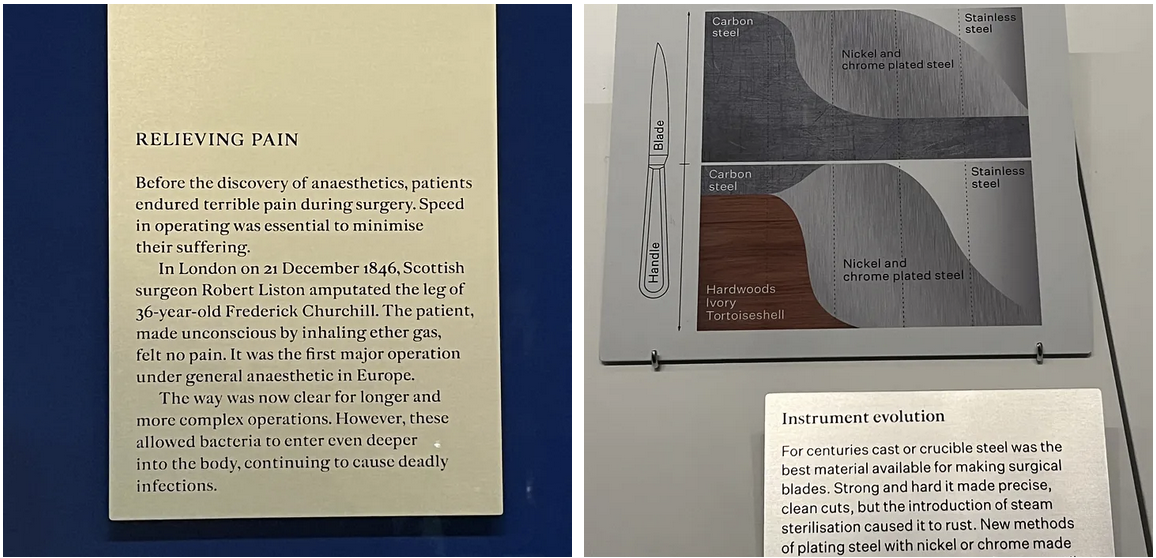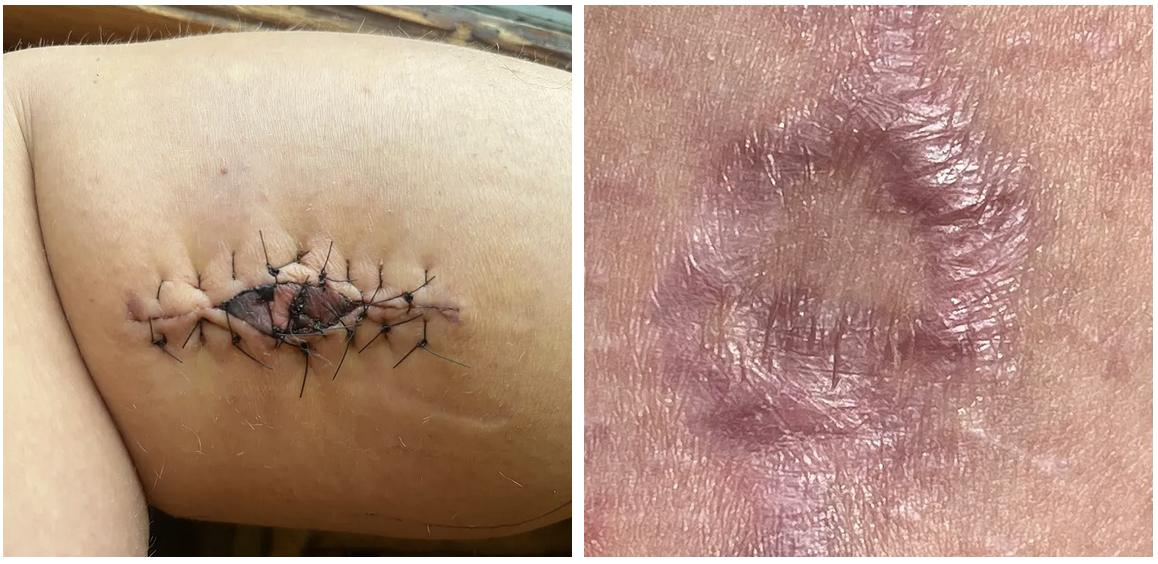I have never heard so many groans in a museum. On every face, there is a conspicuous grimace, including on the fragmented skulls and stray mouth bits leering out from jars in which they are suspended in pickling spirits. But behind the visitor’s furrowed brows and crinkled up noses is a palpable curiosity. Each of us walks through transfixed, conscious of every sensation inside our body. It reminds me of when I used to seek reassurance that I was not suffering from a serious illness and my dad would ask “But does your tongue feel weird inside your mouth?” Upon his drawing attention to it—it did, and I was sure that death was imminent.
The Hunterian Museum of Surgical History is the most astonishing museum I have ever visited. Primarily home to a collection of specimens belonging to the 18th century anatomist John Hunter, it is also a museum dedicated to the history of surgery and anatomical understanding. As you progress around the small but extraordinarily dense exhibit halls, you move from roman age bronze speculums and surgical probes to displays on organ transplantation and machinery demonstrating robot-assisted operations.
As you enter the museum, you pass a plaque, the last paragraph of which reads:
The museum contains thousands of specimens of human remains, gathered before modern standards of consent were established. We recognise the debt owed to those people named and unnamed - who in life and death have helped to advance medical knowledge.
This is a paragraph worth foregrounding. Even with the soft tissue specimens drained of color (save for those injected with dye to demonstrate the vasculature and nerves), one cannot help but recognize the very real bodies that made the collection possible. The visitor must confront the humanness behind it all. What must it have been like to live with such maladies? Did these people suffer terribly? How were their deaths? Were they alone when they passed?
The first display case gives one a sense of what to expect throughout—a miscellany of pathology, physiology, and comparative anatomy. Among its contents is a stately portrait of John Hunter, a lion’s toe, a horse fetus, and many other morbid oddities. Comparative anatomy, the similarities and differences of shared features across the animal kingdom, fascinated John Hunter. His collection not only holds human remains, but a staggering amount of soft-tissue and skeletal samples from organisms big and small, elephant skulls to pupating wasp larvae. Things of a kind are arranged together, so that the resemblances stand out.

As you turn from the first case, a display across the room is bound to catch your eye. These are known as the Evelyn Tables, and they are the oldest anatomical preparations in Europe made in the mid-1600s. Comprising four large pine boards each displaying a different part of the human body—nerves, veins, and arteries all coated with varnish, they give the room an eerie glow. The way that the vasculature splays across the boards gives the impression of the denuded stalks of ivy vines clinging to a brick wall or slime mold blooming from a petri-dish. It is only when you look closer that you see the unmistakable shape of human skeletons.
The next display leaps forward to the 18th and 19th century, where you read about the frenzied hunt for corpses for anatomical schools. Caricatured in a series of paintings and prints, one cannot help but feel unnerved by the variety of ways with which dead bodies were procured and dissected. As human cadaveric dissection was forbidden by the Catholic Church into the 16th century, early surgeons had to work in secret. It was such that a clandestine industry sprung up around them, with bodysnatchers robbing freshly laid graves and destitute people selling their recently deceased relatives. Despite various ordinances and charters enabling prominent universities to procure bodies of hanged criminals, the market for additional cadavers was considerable. Even John Hunter, brilliant though he was, was not always principled in his approach to sourcing bodies, and it wasn’t until the mid 19th century that voluntary donation became the norm.
Were I a pauper in a workhouse in the 1800s, I would have likely loathed these body snatchers, or, “resurrectionists” as the more dignified gentleman took to calling them. Surely, tales of their insatiable appetite for hocking corpses would have struck fear in me and I would have dreaded what might happen to my flesh after my death. Yet, today as a 21st century visitor to the museum, I cannot help but feel a debt of gratitude to these early entrepreneurs. Without them, and without those early surgical pioneers, we would not have the understanding of human physiology and pathology that we do today. Their macabre efforts moved the needle, and this advancement is precisely what the Hunterian Museum celebrates.

Even so, as you move into John Hunter’s personal collection, lofty thoughts about progress and early innovators temporarily recede. Here, under a sickly glow, you see jars upon jars filled with every conceivable organ and blight that you can imagine. You can marvel at what syphilis does to a human skull and see the effects of the “Gin boom” on a liver. While ghastly, the collection is marvelous. It isn’t all gloomy either, in some cases, the specimens are donations made by known individuals who survived their surgeries and only succumbed to old age years later.
In an abutting room, another plaque speaks to the question of “relieving pain,” which reminds visitors that the best surgeons used to be the ones who could complete operations the fastest. Before anesthesia, surgeries were agonizing affairs, often sprung upon patients with little warning so that they did not have time to panic. However, even after the first analgesics were discovered, it was not a straight road to improvement. With patients unconscious, doctors could leave incisions open longer, exposing patients to harmful microorganisms. It took another leap before the importance of sterilization was recognized.

Last winter, I had surgery to remove a melanoma on my leg. This was done with lidocaine (local anesthesia) and sterile instruments. It was done by a surgeon with an understanding of germ theory and the importance of asepsis. The pathology was removed in its early stages, before greater damage could ensue. These were not luxuries afforded to those under John Hunter’s knife, but rather the hard-earned fruits of medical advancement.
An admitted hypochondriac in a room filled with pustules and polyps, I had to remind myself of what the author Bill Bryson wrote in his book The Body, that, despite everything that can go awry in the human body, it mostly hangs together. We tend toward equilibrium and wellness. But should it go wrong, as the specimens in the Hunterian remind you it can, then understanding the root causes of our affliction becomes crucial.
Before leaving the museum, guests are presented with one last room of modern surgical techniques. When I was there, several of us watched a video of a girl and her doctor discussing her jaw surgery. The doctor explains that in the past, the surgery required that patients stay in the hospital for weeks, unable to eat solid food for days. Now, she said the girl would go home the following day, experience very little pain, and be able to eat almost immediately.
When I got my melanoma removed, I asked my general surgeon about the cadence with which he uses new instruments and learns new techniques. To my chagrin, he said that his field hasn’t really changed since laparoscopy in the 80s. He still carves into people, removing hernias and large slabs of flesh the way that he learned decades ago. I left with over 20 stitches and a wound that took months to close, the scar of which still imprints my skin.
We cannot take progress in medicine for granted. It is hard fought and dearly won. Even with the lidocaine, I couldn’t help but feel a little butchered. I want stitches that all melt away entirely; treatments that dissolve my melanoma with powerful lasers. I want an army of John Hunter’s all self-experimenting and relentlessly pushing for new breakthroughs.
Ultimately, we do indeed owe an enormous debt to the people whose remains are on display in the Hunterian. We also owe, I believe, another to those who took their deaths as an opportunity to improve the lives of the living, including us, and all future beneficiaries of yesteryear’s macabre.

[Thank you for reading–this piece is cross-posted from my blog]
